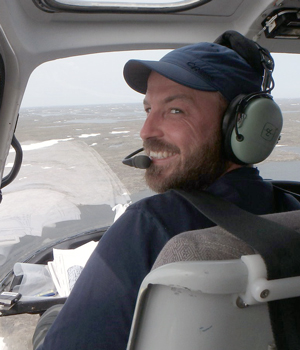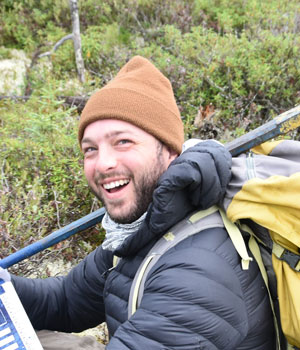Back to program
Geological Heritage of the Quaternary: Sedimentary Archives and Applications
Tusday, November 18, 2025
Room 403 – Espace géoscientifique
The Quaternary surface deposit cover is ubiquitous throughout Quebec. Its thickness and sedimentological characteristics vary greatly and are evidence of the episodes that punctuated the last glacial cycle and subsequent deglaciation. An obstacle to mineral exploration for some, a recharge area for surface aquifers for others. This layer has multiple uses and presents several challenges in terms of land and resource management.
This conference session will provide an opportunity to explore various research topics related to surface mapping, glaciosedimentary prospecting, natural hazards, and the development of technologies and applications relevant to this sedimentary layer.
9:30 a.m.
Mapping Surface Deposits and Mass Movements in Eastern Hudson Bay and James Bay: Implications for the Morphosedimentary Evolution of an Emerging Coastline
Conference details
In recent years, major, highly retrogressive landslides have occurred in the sensitive clays deposited in the former Tyrrell Sea, SE of Hudson Bay and NE of James Bay. Three areas have been particularly affected by these landslides (Grande rivière de la Baleine, Petite rivière de la Baleine and Rupert River) and their proximity to the communities of Kuujjuarapik and Waskaganish raises concerns about the associated risks. Given these concerns, it is imperative to gain a better understanding of the morphostratigraphic context of landslides and the sedimentary environments in which they develop. Analysis of high-resolution digital terrain models (DTMs), derived from recent LiDAR data, has enabled systematic mapping of surface deposits in order to delineate the different morphosedimentary units and the distribution of clay deposits in the study areas. Recent field validation work has enabled the nature and characteristics of these sedimentary bodies to be specified and preliminary information concerning their stratigraphy and architecture to be gathered. This surface deposit mapping project also provides a unique opportunity to: 1) retrace the history and dynamics of deglaciation in eastern James Bay and Hudson Bay, making it possible to specify the chronology and emplacement mode of sedimentary bodies that are now liable to be remobilized by mass movements; and 2) refine the glacio-isostatic rebound models for the region by developing an emergence curve using the cosmogenic nuclide dating method. This data is essential to better understand the evolution of the landscape and to identify the causes of highly retrogressive landslides in the sensitive clays of the former Tyrrell Sea, now subject to a very rapid rate of base level decline.
9:50 a.m.
Synthesis of the Geology of Surface Deposits in the Cape Smith Belt, Nunavik, Québec
Conference details
The great glaciations of the Quaternary shaped most of the northern part of the Ungava Peninsula, depositing a sedimentary cover that varies in thickness and in places limits access to the bedrock. Glaciosedimentary prospecting is proving to be an essential tool for characterizing the mineral potential of certain sectors of the Nunavik region, already recognized for its nickel potential. This presentation looks at the Quaternary geology of an area south of Salluit and Deception Bay, covering 15 NTS sheets at 1:50,000 scale, an area of just over 11,000 km².
Surface formations were mapped at a scale of 1:50,000, and glacial (till) and fluvioglacial (esker) sediments were sampled over the course of three field campaigns in the summers of 2021, 2022 and 2023.
The study area is located in the Churchill Province, within the Ungava Orogen, which comprises four lithotectonic domains: North, South (forming the Cape Smith Belt), Kovik and Narsajuaq.
Surface deposits consist mainly of till, in places reworked by meltwater. Fluvioglacial formations (sandy-gravel eskers) and proglacial outwash locally cover the glacial sediments. The bedrock is sparsely exposed, often gelifracted, and includes mature felsenmeers in the Puvirnituq mountains.
Rapid deglaciation of coastal areas and large valleys in the north of the Ungava Peninsula coincided with a marine incursion into the Foucault River valley and lakes Françoys-Malherbe and Watts. The glacial retreat also formed proglacial lakes in ice-clogged valleys (Watts, Deception, Foucault, Gatin, Vanasse, Derville and Puvirnituq). More than a hundred elevation measurements taken with a differential GPS were used to determine the regional deglaciation pattern.
There are few tapered landforms in the area. However, an exhaustive inventory of glacial erosion marks and eskers has enabled us to better define the glacial dynamics of the region.
Sectors of interest highlighting different metallogenic contexts (Ni-Cu-Co [PGE], VMS, gold, and Li-REE) were identified following the analysis and interpretation of geochemical sampling results and heavy mineral concentrates.
10:25 a.m.
The Contribution of LiDAR DTMs to Quaternary Mapping: The Case of Glacial Lakes Barlow and Ojibway
Conference details
The retreat of the Laurentide ice sheet across eastern Ontario and SW Québec led to the formation of Glacial Lake Barlow in the upper Ottawa River basin. Lake Barlow expanded northwards and eventually joined Glacial Lake Ojibway, forming a lake system that later merged with Glacial Lake Agassiz towards the end of deglaciation. Although Lake Barlow is central to the reconstruction of the last phases of deglaciation, its history and connection with Lake Ojibway remain poorly defined. To improve understanding, a detailed mapping of uplifted shorelines and other indicators of lake levels has been carried out in the Barlow basin using LiDAR-derived digital terrain models.
The lake levels of Lake Barlow have been reconstructed from 22,330 points of shoreline elevation and paleosurfaces, taking into account post-glacial rebound. The shorelines at high and medium altitude show a gradual decrease in the lake surface, reaching a well-defined level at intermediate altitude that marks a significant period of stability. The new shoreline sequence exhibits strong continuity with that reported for the Lake Ojibway basin to the north, indicating that these lakes formed a single body of water during much of the glaciolacustrine episode.
These results contrast with previous models, which proposed several lacustrine phases controlled by a series of rock sills along the upper Ottawa River. However, analysis of elevation points corrected for glacio-isostatic sinking suggests that, during the early glaciolacustrine stages, the waters were probably dammed by the Lake McConnell moraine and/or by glaciofluvial deposits. The emergence of a rocky sill in the median part of the basin, near Angliers, marked the end of the Barlow-Ojibway episode and the beginning of the stable phase of Glacial Lake Ojibway. This lacustrine configuration came to an abrupt end around 8.22 ka, following the final drainage of the lake.
After this subsidence, lakes Barlow and Ojibway evolved independently until their disappearance, leaving behind small postglacial lakes in isolated basins. These results allow paleogeographic reconstructions to be refined and provide key data for modelling the volumes of meltwater needed to assess the impact of freshwater discharges on ocean circulation and climate.
10:45 a.m.
Genesis and Chronology of the Harricana Moraine: Contributions of Sedimentology, Sediment Provenance and Cosmogenic Isotope Dating
Conference details
The Harricana Moraine is one of the most imposing glacial forms in North America. This vast fluvioglacial complex extends over more than 1,000 km along a north-south axis, from Témiscaming (46.7° N) to just south of James Bay (52° N). Although it is generally interpreted as the product of the southern margin of the Laurentide Ice Sheet splitting into two distinct fronts, a number of sedimentological and geomorphological observations suggest a more complex genesis. Minimal radiocarbon (¹⁴C) ages around ~11 ka cal BP allow for the dating of the glacial margin at the southern end of the moraine, but the chronology of the medial and northern segments remains poorly defined. To gain a better understanding of these dynamics, systematic mapping of landforms was carried out in four key areas using digital terrain models derived from LiDAR, combined with fieldwork, analysis of clast petrography, and sedimentological measurements. Nineteen blocks, spread over eight sites covering a 400 km transect, were also dated by cosmogenic isotopes (¹⁰Be). The results of this work reveal a superposition of several emplacement processes along three main segments. The clasts show a homogeneous composition over most of the trace, except to the north where the presence of Palaeozoic carbonates and Proterozoic wackes from the Omarolluk Formation testifies to a contribution associated with the Cochrane glacial readvance(s), originating from the NNW. In the southern segment, in Témiscaming, mapping reveals numerous elongated forms indicating emplacement in association with a dominant and uniform flow towards the SE. In the central part, near the Roulier Moraine and Val-d'Or, the geomorphological features reflect an emplacement in an interlobar position between the fronts of the Hudson Bay and Quebec-Labrador domes. Preliminary ¹⁰Be ages provide a more precise chronology for the moraine and place constraints on the rate of regional glacial retreat. Collectively, these results shed new light on the influence of glacial fronts in the genesis of this fluvioglacial system, as well as on the variability of glacial dynamics during the final stages of deglaciation.
11:05 a.m.
Evidence of hydrogeological and stratigraphic controls on sinkholes and gully formation in a thick Quaternary sequence, Trois-Rivières, QC
Conference details
Internal erosion in granular soils is caused by mechanisms such as suffosion, contact erosion, and piping. These mechanisms lead to the detachment and transport of particles from their original environment due to groundwater flow. Near Trois-Rivière, a case of internal erosion was observed, marked by the formation, within a few months, of a gully accompanied by circular depressions affecting the ground surface around Bellemare Creek, a tributary of the Saint-Maurice River.
The Quaternary deposits in this area were studied using a multidisciplinary approach, that combines geomorphology, stratigraphy, hydrogeology, geotechnics and geophysics. Theses thick deposits consist of a succession of a succession of glacial and non-glacial formations composed of lithological units with contrasting grain-size distributions, physical, and hydraulic properties. Grain-size analysis reveals that certain formations are particularly susceptible to internal erosion mechanisms, notably suffosion and contact erosion.
Hydrological analysis suggests a diachronic activation of these mechanisms, initially leading to the formation of sinkholes, followed by the rapid development of the gully.
On the right bank of the Bellemare creek, the sinkholes likely appeared early, when the units susceptible to internal erosion became saturated below the groundwater level. On the opposite bank, the gully developed more recently, once conditions favorable to internal erosion were met, especially, a high-water table level above vulnerable units.
This gullying was facilitated by a sapping erosion, which weakens the stream’s slopes. Internal erosion remains poorly studied in Québec due to its complexity and the need to integrate approach.
11:25 a.m.
Closing remarks






